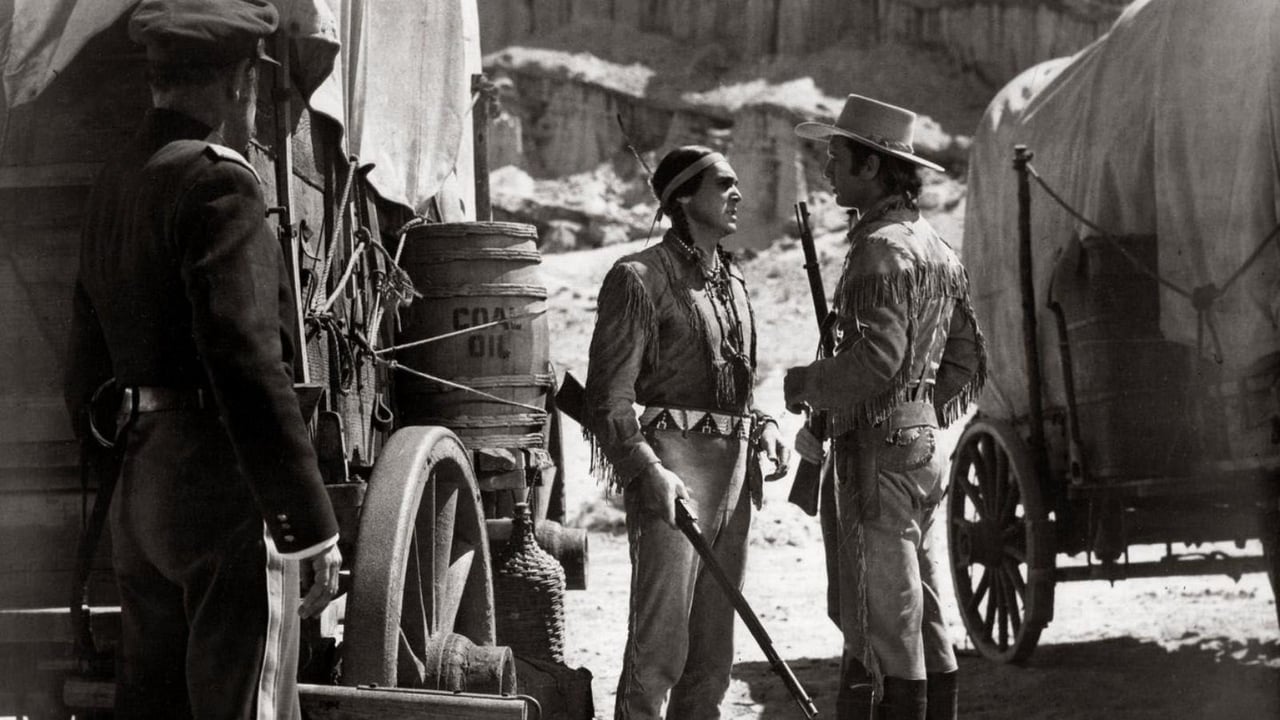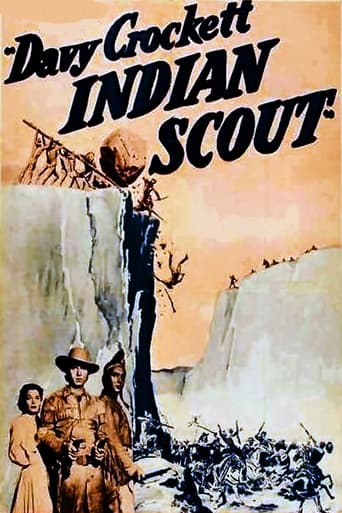Stometer
Save your money for something good and enjoyable
Doomtomylo
a film so unique, intoxicating and bizarre that it not only demands another viewing, but is also forgivable as a satirical comedy where the jokes eventually take the back seat.
FirstWitch
A movie that not only functions as a solid scarefest but a razor-sharp satire.
Kien Navarro
Exactly the movie you think it is, but not the movie you want it to be.
JohnHowardReid
SYNOPSIS: The title is a bit of a "have", as this Davy Crockett is not the famous king of the wild frontier, but a fictitious military scout who happens to be named after that "uncle".
COMMENT: This picture utilizes so much footage from Kit Carson (1941) that Mescall is credited as co-photographer (he retired in 1945). However, it's not only well matched by Diskant but smoothly integrated by the editors. And it's such superbly spectacular footage that we don't at all mind seeing it again in these new surroundings. In fact Mescall's footage actually looks more impressive here than it did in Kit Carson where it was undermined by both poor acting and indifferent direction - plus the offset of a long and tedious anti-climax. Arthur Rosson directed the Mescall scenes. The rest of Davy Crockett is handled by Lew Landers in a what can only be described by his humble standards as a fairly lively fashion. The principals play competently enough, and the pacing appears reasonably fast. True, the dialogue sounds cliched, whilst the characters present themselves as little more than the usual stereotypes; but, all told - and thanks chiefly to the attractive Diskant/Mescall cinematography - this Davy Crockett comes across as likable enough entertainment for undemanding action fans.
bkoganbing
In case you're wondering about how in 1848 Davy Crockett could be leading wagon trains west after being killed at the Alamo, this is not THE Davy Crockett, but a descendant of same. Even Hollywood with its penchant for taking the names of real frontier characters and weaving wholly fictional plots around them couldn't really mess with this one.This Crockett film features George Montgomery as a Davy Crockett and he's a scout for the army and civilian wagon trains going west and he's got two sidekicks, Noah Beery, Jr. and Philip Reed. They're doing both working for the army and guiding a wagon train west among the passengers are a half Indian woman played by Ellen Drew and a mute driver.But he's like Bernardo in the Zorro series, it's a pose so he can hear all kinds of useful information to take back to Drew's father who is Robert Barrat the chief of the Kiowas who are looking to make another Indian confederation in the tradition of Pontiac and Tecumseh.Drew's working for her dad too until she gets a little romancing from Reed who is also an Indian. But he's in the Ed Ames tradition, he may wear the Indian costume, but he's been educated in the white man schools and has some manners about him.My guess is that Drew liked an Indian with a vocabulary that was more than 'how' and an occasional grunt. Back in the day that is the picture Hollywood gave us of the Indian. Anyway it was unusual for the sidekick to be getting the woman or even showing an interest in one in Hollywood westerns.The silliness of the plot is ameliorated by enough action to satisfy any B western fan. And Philip Reed did strike a blow for sidekicks every where in getting the girl in a western. Albeit he was not a traditional sidekick.
zardoz-13
Rugged, clean-cut, square-jawed George Montgomery plays the heroic title character in this atmospheric, large-scale, but low-budget wagon train/cavalry versus Indians western. "Davy Crockett, Indian Scout" generates a modicum of suspense in its mystery about a treacherous informant within the settlers' camp. This scoundrel keeps the Indians abreast of the changing route of the wagon train. Everything begins with an Indian attack on a wagon train heading for California in 1848, and the U.S. Army amasses evidence that concludes that a spy lies at the bottom of this treachery. The military convenes a hearing about the matter. White settler Mr. Sims (Erik Rolf of "U-Boat Prisoner") insists that their Cherokee scout Red Hawk (Philip Reed of "Unknown Island") is the guilty party. Red Hawk's longtime friend, Davy Crockett (George Montgomery of "Pawnee"), refuses to stand by and let Simms tar and feather Red Hawk with his groundless accusations based purely on racism. Davy reminds them that everything turned sour the moment they entered Kiowa country. At that moment, this western shifts into flashback mode. Red Hawk and he ride away to pow-wow with Kiowa chief Sleeping Fox (Chief Thundercloud of "The Searchers"), but the intractable Fox demands that Davy turn the wagon train around and leave the territory. Davy explains that he cannot accommodate Sleeping Fox, so the Kiowas try without success to kill Red Hawk and Davy. Our heroes make it back to the wagon train by the skin of their teeth. Later,things begin to boil with the arrival of a pretty white schoolmarm, Francis Oatman (Ellen Drew of "Stars in My Crown"), and her deaf-mute driver Ben (Paul Guilfoyle of "The North Star")who looks mighty suspicious. Davy rides out and rescues Oatman and Ben from a war party of Kiowas. Naturally, Davy becomes infatuated with the comely Miss Oatman. This flashback concludes with the introduction of the schoolmarm and Davy's romantic ambitions. The film reverts to the present just long enough for Red Hawk to refute Sims' next accusation about his absence from camp before the Indian attack. Later, in town, Davy sees Ben and believes that the deaf mute was talking with an Indian. Later, Davy tries to expose Ben's masquerade by firing his six-gun behind him in camp without warning. What Davy doesn't know is that Ben knew about Davy's scheme. He caught a glimpse of Davy fidgeting with his gun in a mirror so that he was prepared not to flinch at the sound of the thunderous gunshot."Tailspin Tommy" director Lew Landers directs this sprawling black & white western with flair and efficiency. Although he stages several scenes on obvious studio sets as a cost-cutting measure, he doesn't shrink from depicting the big action scenes in the great outdoors during the Indian rampage sequences. These scenes bolster an otherwise pallid western and makes it worth watching, especially if you enjoy horse operas. You can tell from the arid settings that these large-scale scenes were filmed out in the desert far away from a sound stage. Furthermore, the film benefits from the cat and mouse games that the Indians and the settlers indulge in when they have to decide which route to the fort is quicker or safest. The resolution to the mystery is well-handled, though the happy ending outcome is perhaps a mite far-fetched. Incidentally, Montgomery's Davy—in the film--is a distant relative from the real Davy. As the civilian tracker for the wagon train, amiable Noah Beery, Jr., who played in the James Garner television series "The Rockford Files," contributes another solid supporting performance. Surprisingly, the hero doesn't get the gal, but the happy ending has the true-hearted lovers getting hitched. it's still a happy ending. All in all, "Davy Crocket, Indian Scout" doesn't hold a candle to anything that John Ford directed, but neither is this black & white United Artists release a bad oater.
bux
This run-of-the-mill western is mostly made up of stock footage from Edward Small's earlier frontier epic, "Kit Carson" (1940). They've dressed Montgomery in the same wardrobe as Jon Hall wore in the earlier film, so they even have used some of the non-action scenes stolen from "Carson".If that wasn't bad enough, the plot is tired, the acting poor, and if their was any director on the set, he must've stepped out for a short beer during the shoot. If you ever were expecting Disney's version of Crockett, or Fess Parker, forget it! They threw this mediocre little western BACK on the theatre screen in 1955, at the height of the Crockett hysteria, for a fast buck. Those of us that paid that buck, left the theater in tears! A worthwhile experience, though-it taught us not to trust Hollywood!


